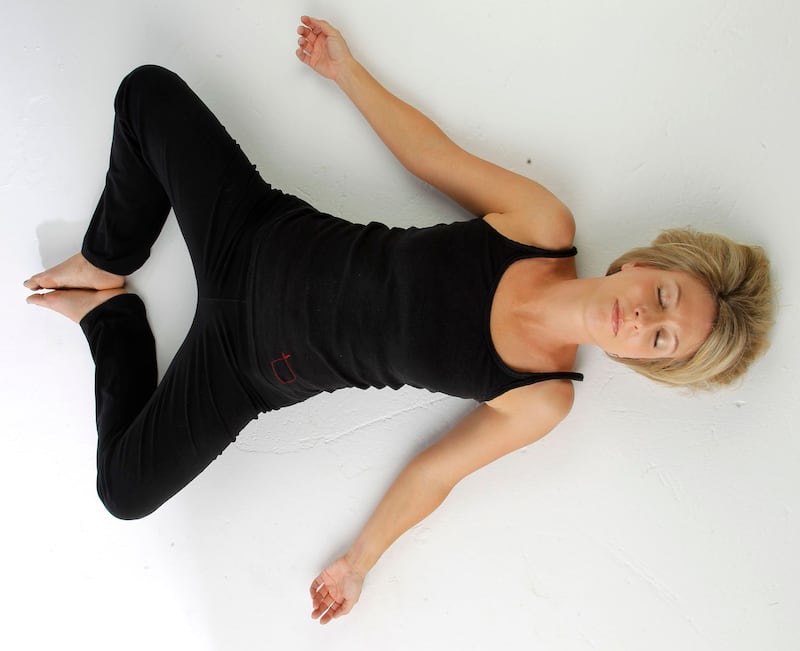If you want to know about the wonders of a healthy pelvic floor, you could do worse than look to Coco Berlin, who styles herself "Germany's most famous belly dancer". Berlin started belly dancing in 2002, but it wasn't until a few years later, when she went to Egypt to study dancers there, that she wondered why they were so much better. She concluded they were seriously in touch with their pelvic floor, the internal muscular structure that supports the internal organs and prevents incontinence, among other important functions.
"When I connected to my pelvic floor, for the first time in my life, I had this feeling of embodiment," Berlin says. It improved her dancing – before, she says, it had felt "like mimicry" – but also affected the rest of her life. She felt more confident: "I had the feeling that I own my body." Her enjoyment of sex was greatly improved, and she felt stronger and less stressed. She thinks it is a prime reason why people assume she is much younger than she is. (She's 42; speaking over Zoom from her home in Germany, she looks like a woman in her 20s.)
Berlin is about to release the English translation of her book Pussy Yoga – I think I see her wince a little at the title – to share her enthusiasm for pelvic-floor health. “Normally, the pelvic floor is only something that you get in touch with when you’re pregnant, incontinent or having other issues,” she says. “It was such a fringe topic.”
Nobody in the world of pelvic-floor health would say the increased awareness is a bad thing – up to one-third of women will experience a pelvic-floor problem – but many women have no idea what a pelvic floor is or its purpose
It certainly has been – blame a historical lack of interest in women’s health, as well as squeamishness about anything to do with sex and bodily functions – but that has been changing in the past few years.
The idea of “yoga” for the vagina may be the latest way to target women’s undercarriages, but it comes on the back of an increased number of features in women’s health magazines about pelvic floor exercise, the launching of relevant apps (such as Squeezy, which sets exercise plans and sends reminders) and devices that train you from the inside.
One of the best-known devices, the Elvie Trainer – it is inserted into the vagina, and you can monitor your pelvic-exercise achievements on your phone – launched in 2015; the Financial Times recently ranked Elvie 41st out of Europe's 1,000 fastest-growing companies. There are podcasts, such as Why Mums Don't Jump, hosted by the broadcast journalist Helen Ledwick, which are aimed at ending the stigma about vaginal prolapse and incontinence and other issues with pelvic-floor dysfunction.
Nobody in the world of pelvic-floor health would say the increased awareness is a bad thing – up to one-third of women will experience a pelvic-floor problem – but numerous surveys still show many women have no idea what a pelvic floor is or its purpose. One survey of 1,000 women found one in six didn’t know where it was, and one-quarter didn’t know what it did.
"It's a part of the body people haven't been given nearly enough information about for years," says Amanda Savage, a pelvic-health physiotherapist. "The wonderful thing about pelvic health is there are a lot of things you can do that will improve the situation, through natural methods – exercise, diet, knowing how to help your bowel empty well, knowing how the bladder fills and empties. There's a lot one can do to help oneself. It's a shame when people haven't found out about those things they could be doing, and they are, like, 'Why did nobody tell me this 10 years ago?'"
Celebrities are more likely to be open about pelvic health, Savage says. The reality-TV star Ferne McCann has talked about the prolapse she developed after giving birth, and the comedian Joanne McNally spoke about her pelvic floor on a chatshow last month.

But could this become yet another body part women are supposed to be anxious about? With our outsides under more scrutiny than ever, do we need to start worrying about the insides too? "I think it's everything in moderation," says Suzanne Hagen, professor of health-services research at Glasgow Caledonian University, who researches pelvic-floor disorders. "I think there has to be raised awareness, probably as young as school age, about the pelvic floor, what its job is and how it's going to change over time."
There is, she says, increasing evidence to suggest that even if you don’t have a problem, pelvic-floor exercises could prevent one in future, but she adds: “I don’t think it’s something we should be making women panic about.” It is not about “women fixating on another part of their body that they have to have in prime condition. I see it as part of a general healthy lifestyle and looking after your body to take you through its life course.”
Pelvic-floor exercises (known as Kegels in the US, after the gynaecologist who devised them) are based around contracting and relaxing the muscles that you can use to stop urine midflow, although health professionals don’t recommend doing this regularly, as it could lead to a urinary infection. In men and women, exercises are used to treat symptoms of incontinence. In men, exercises can also help with maintaining a strong erection. For women, they can help with pain during sex, as well as issues caused by childbirth such as vaginal prolapse, but Hagen points out that they are “not the answer to everything. Some women do have quite traumatic births, and there’s a lot of damage done to the pelvic floor, so that’s not something that’s going to be easily offset by exercises. Some women do need surgery to correct problems.”
The pelvic floor is made up of a group of muscles. A weak pelvic floor is an issue, but so is a pelvic floor that is too tight, which can cause problems such as pain during sex and an inability to empty the bladder or bowels. "We need balance in these muscles," says Lucia Berry, a pelvic-health physiotherapist and lecturer at Brunel University, in London. We need to be able to relax them to get stuff out (urine and stools) and, if we want to, stuff in.

With a healthy pelvic floor, “what people should really feel is confidence”, says Berry. You shouldn’t be fearful of leaking urine if you cough, for instance. “You’re able to hold urine really well and then, when you get to the toilet, you’re able to relax and have a really good wee. And there should be good sensation with sex.”
Pregnancy and childbirth can weaken the pelvic floor, as can hormonal changes during menopause. In both men and women, ageing is associated with a loss of muscle tone to the area. Your pelvic floor can also be affected by lifting heavy weights, being overweight or having a chronic cough, all of which put pressure on those internal muscles. Chronic constipation also doesn’t help.
Although the links aren’t fully understood, athletes also seem to be at risk – girls who do a lot of gymnastics, and long-distance runners, can experience symptoms of pelvic-floor dysfunction, such as urinary incontinence. A sudden enthusiasm for high-intensity interval training or weight-lifting may come with unwelcome side effects.
You should “build up your foundation muscles – your lower abs and your pelvic floor – first before you add weights and kettlebells”, says Savage. “Sometimes when people have gone at things a bit too quick, they have done what they can see on the outside – they are lifting the weights and haven’t thought about what is happening on the inside. And then you could potentially be bringing on pelvic-floor symptoms, prolapse or leakage because you haven’t realised you’ve got this mismatch.”
Many people don't know how to do a pelvic-floor exercise correctly. It is important to ensure you are doing them correctly, 'so you're not pushing down, bearing down, and making your symptoms worse'
What is starting to become clear is that everyone could benefit from pelvic-floor exercises. In women with symptoms of a weak pelvic floor who have sought treatment, says Berry, a strengthening programme would consist of exercises probably two to three times a day, and it could take up to four months to build strength.
But, if you are in your 20s or 30s without symptoms, how often and for how long should you exercise your pelvic floor? “That’s the million-dollar question,” says Hagen, who adds that there is still little research: “It’s probably a case of trying to do them [the exercises] at a maintenance level if you’re in a non-symptomatic group.”
How much to do would be a personal decision. Going overboard could be counterproductive, says Berry. Anxiety can cause tension in the area, she says, and becoming fixated on the health (or not) of the pelvic floor, combined with really exercising it, can result in a muscle that is too tight or strong. “I don’t know if it’s the exercise that causes the problem, or the anxiety.”
Many people don’t know how to do a pelvic-floor exercise correctly. Berry says it is important to ensure you are doing them correctly, “so you’re not pushing down, bearing down, and making your symptoms worse”. Many women, she points out, can’t move the muscles at all, which could lead to unnecessary anxiety, which in turn could create problems where none should exist.
She advises a self-examination with a mirror. “See if you can squeeze your vagina. The vagina should move – it should close and open. If you can’t see or feel that, you’re probably not doing it right.” However, she says, if you don’t have symptoms, “I wouldn’t worry , because those muscles are clearly working to control the bladder and bowel.” (If you do have symptoms, see your GP.)
What all the physiotherapy experts agree on is that you don’t need to buy a device, many of which such gadgets cost more than €100. “We did a trial looking at women who already had urinary incontinence. Half had training from a therapist, and half did the therapy but also used a device that measures the squeeze when doing the exercise,” says Hagen. “We wanted to see whether that helped the women do the exercises better, be more motivated to do them, and therefore that their continence might be better in the end. What we found was, on average, there was no difference between the groups. If you’ve got a really good programme of pelvic-floor-muscle exercise, you don’t need to have a biofeedback gadget.”
Coco Berlin is so dedicated to her pelvic floor that she does activities, such as dancing and Pilates-inspired movements, for it throughout the day, and even squats on the loo seat so as not to put pressure on her internal muscles and organs
“There is no clinical evidence to say that using a device is going to help you get the exercise right,” agrees Berry. “If you can contract your pelvic floor correctly, and do the exercises, you don’t need to spend any money on a device. Other people find it hard to do regularly, so having a device can help with motivation.” When it comes to apps that remind you to do the exercises, Hagen says: “If that’s the way you’re wired and you like those types of things, I think that’s a perfectly good thing to do.”
As for Berlin, she called her book Pussy Yoga because although “I’m not a real yogi”, strengthening her pelvic floor “was a spiritual journey for me”. We sit all day, we stare at screens and feel disconnected from our bodies, she says. Berlin doesn’t only do vaginal exercises – “I don’t just squeeze a little bit here and there” – but is so dedicated to her pelvic floor that she does activities, such as dancing and Pilates-inspired movements, for it throughout the day, and even squats on the loo seat so as not to put pressure on her internal muscles and organs.
“I’m very open about this, and I think we have to be, otherwise everybody will just stay in this shame spiral,” she says. (Her advice for feet-on-seat toilet training is “first try a few dry runs so you’ll be ready before it gets serious”. If that’s too adventurous, using a step or stool – the furniture kind – under your feet can create a more squat-like position than simply sitting.)
“I am a believer of really integrating the pelvic floor in your organism, like it’s the centrepiece,” says Berlin. She promises great, if not wholly researched, results. “The first change is always a deeper connection and more awareness about one’s self. You feel sexier, more vibrant and alive.” – Guardian




















